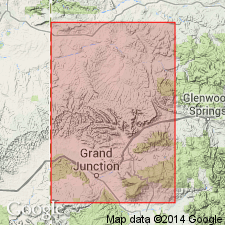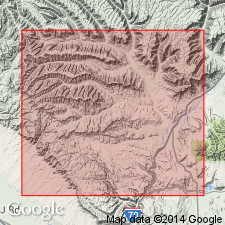
- Usage in publication:
-
- Atwell Gulch Member*
- Modifications:
-
- Named
- Reference
- Dominant lithology:
-
- Claystone
- Sandstone
- Siltstone
- AAPG geologic province:
-
- Piceance basin
Summary:
Named as basal member of Wasatch Formation for exposures along Atwell Gulch, Mesa Co, CO in southern Piceance basin which is designated in its type locality. Measured section in N1/2 sec 26 and S1/2 sec 23, T9S, R97W designated a reference section. Contains a purple, lavender, red and gray claystone, and minor amounts of gray and brown lenticular sandstone and siltstone near base. Is 546 ft thick at reference section. Overlies Ohio Creek Formation; underlies Molina Member, a newly named member of the Wasatch. Collections of Paleocene (Tiffanian) vertebrates and leaves from the basal 200 ft. Paleocene-Eocene boundary placed near top of member.
Source: GNU records (USGS DDS-6; Denver GNULEX).

- Usage in publication:
-
- Atwell Gulch Member*
- Modifications:
-
- Biostratigraphic dating
- AAPG geologic province:
-
- Piceance basin
Summary:
Is lowermost of three members of Wasatch Formation. Study area is in DeBeque area, Mesa Co, CO, southwest Piceance basin. Age diagnostic palynomorphs collected from unit suggest a late Paleocene age. Fossils include MACEOPOLIPOLLENITES AMPLUS (late Paleocene), CARYA (late Paleocene to Oligocene), MACEOPOLIPOLLENITES TRIORBICULARIS (middle Eocene to middle Eocene?), PISTILLIPOLLENITES (late Paleocene to middle Eocene), SYMPLOCOIPOLLENITES (late Paleocene to middle Eocene?), TRICOLPITES ANGULOLUMINOSUS (Paleocene), SYMPLOCOSPOLLENITES (late Paleocene to middle Eocene), and PARAALNIPOLLENITES (Maestrichtian to Paleocene). Cross section. Disconformably overlies Hunter Canyon Formation; conformably underlies Molina Member of Wasatch.
Source: GNU records (USGS DDS-6; Denver GNULEX).
For more information, please contact Nancy Stamm, Geologic Names Committee Secretary.
Asterisk (*) indicates published by U.S. Geological Survey authors.
"No current usage" (†) implies that a name has been abandoned or has fallen into disuse. Former usage and, if known, replacement name given in parentheses ( ).
Slash (/) indicates name conflicts with nomenclatural guidelines (CSN, 1933; ACSN, 1961, 1970; NACSN, 1983, 2005, 2021). May be explained within brackets ([ ]).

